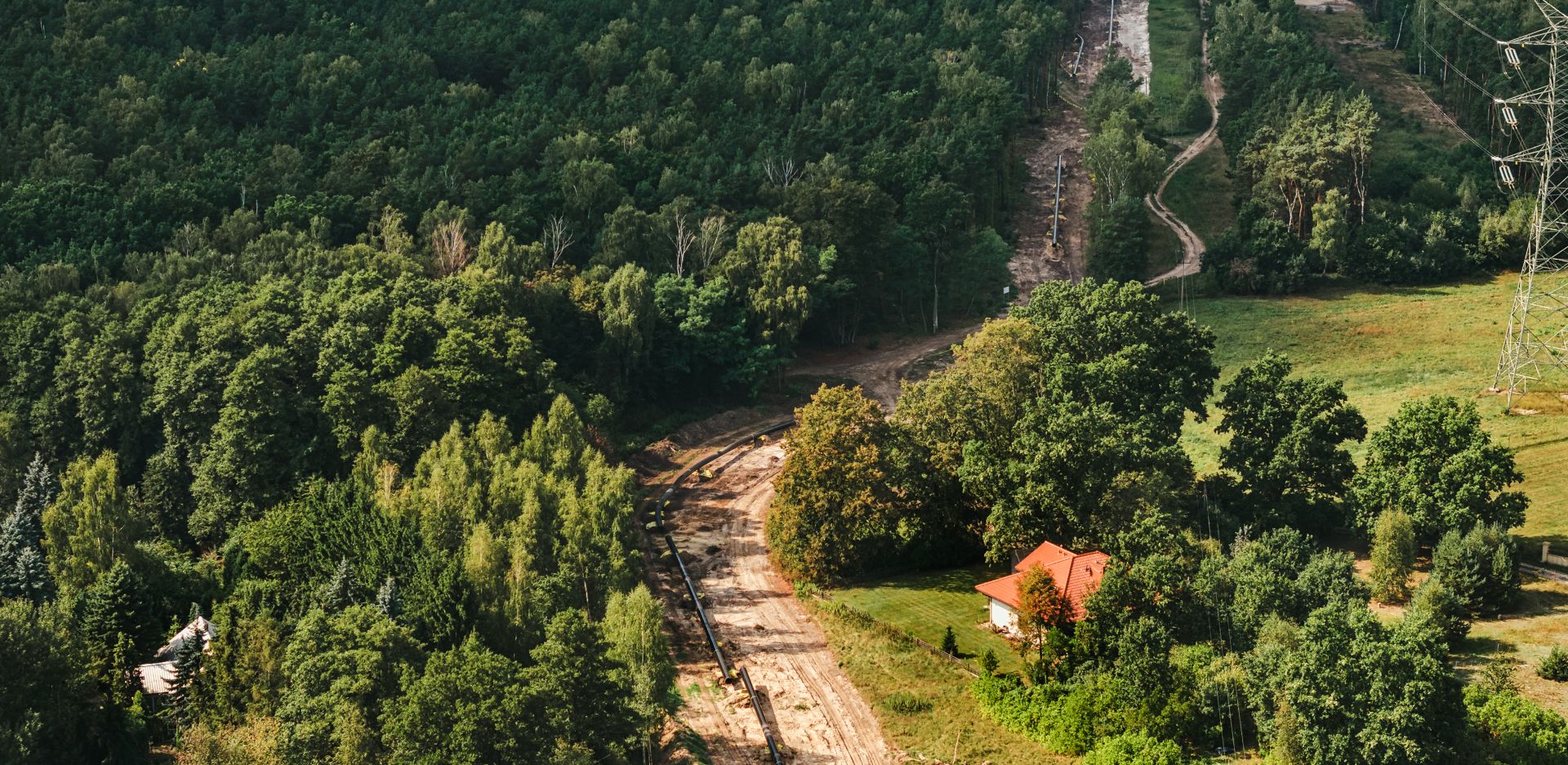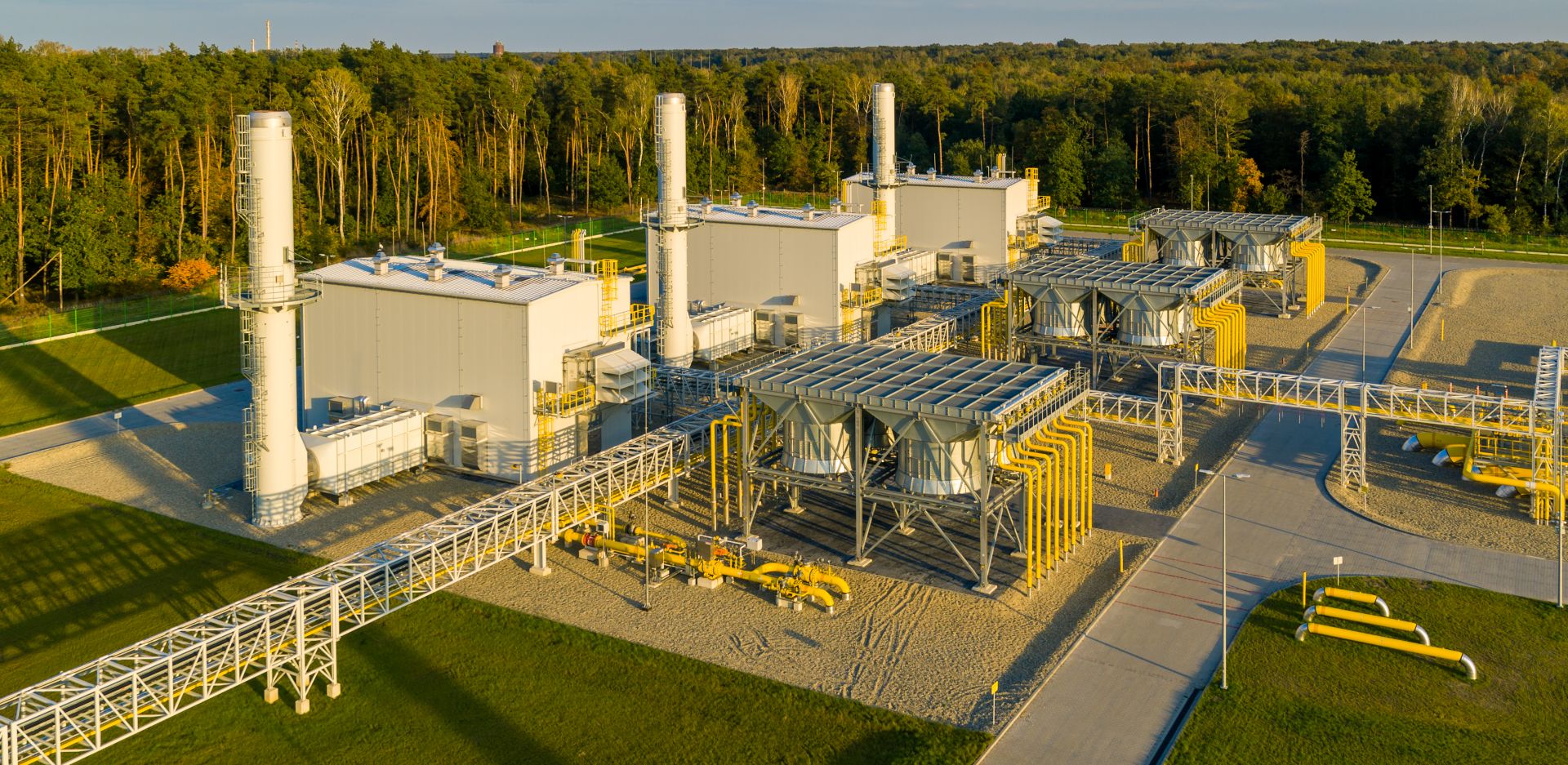| Location | Location in relation to the protected area | Area of operation in km2 | Biodiversity category |
| Zachodniopomorskie Province (municipalities: Banie, Gryfino, Widuchowa, Kozielice, Lipiany, Przelewice, Pyrzyce) | Natura 2000 site: The Płonia River Valley and Miedwie Lake | 2.5 | Terrestrial and freshwater ecosystem |
| Natura 2000 site: Miedwie Lake and adjacent areas | 3 | ||
| Natura 2000 site: The Lower Oder River Valley | 2 | ||
| Natura 2000 site: The Tywa River Valley | 0.1 | ||
| Natura 2000 site: The Lower Oder River | 0.8 |
Biodiversity
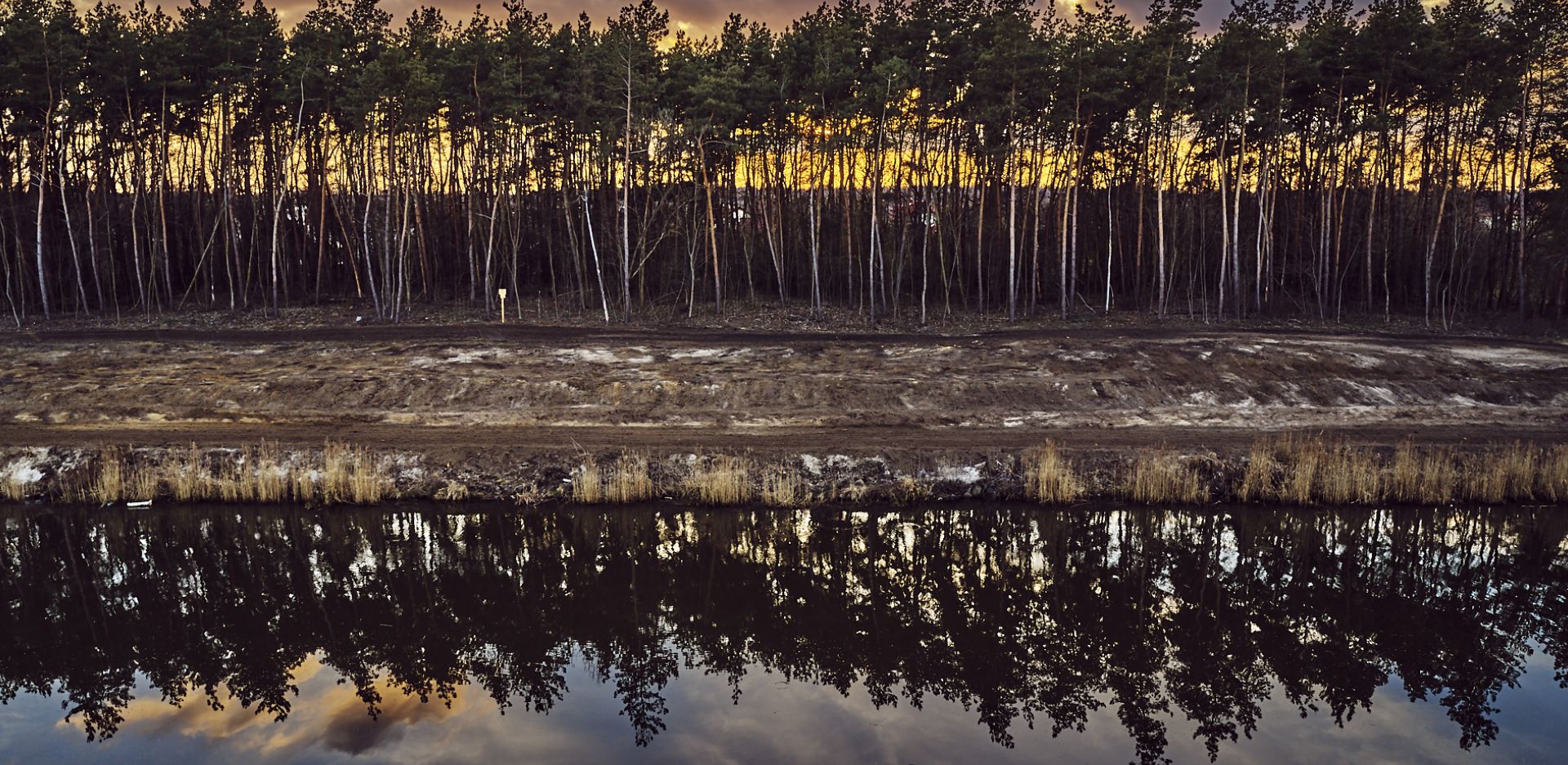
In 2023, the length of gas transmission pipeline network passing through protected areas was 3,631 km, which constitutes 29.2 % of the total transmission network.
-
304-1
-
304-4
-
E-S5
| National parks | Length [km] |
|---|---|
| Drawieński Park Narodowy [EN: Drawa National Park] – buffer area | 3.2 |
| Kampinoski Park Narodowy [EN: Kampinos National Park] – buffer area | 14.1 |
| Park Narodowy Gór Stołowych [EN: Table Mountains National Park] – buffer area | 17.1 |
| Wielkopolski Park Narodowy [EN: Wielkopolska National Park] | 8.3 |
| Wielkopolski Park Narodowy [EN: Wielkopolska National Park] – buffer area | 12.2 |
| Woliński Park Narodowy [EN: Wolin National Park] | 5.8 |
| National Park] – buffer area | 5.4 |


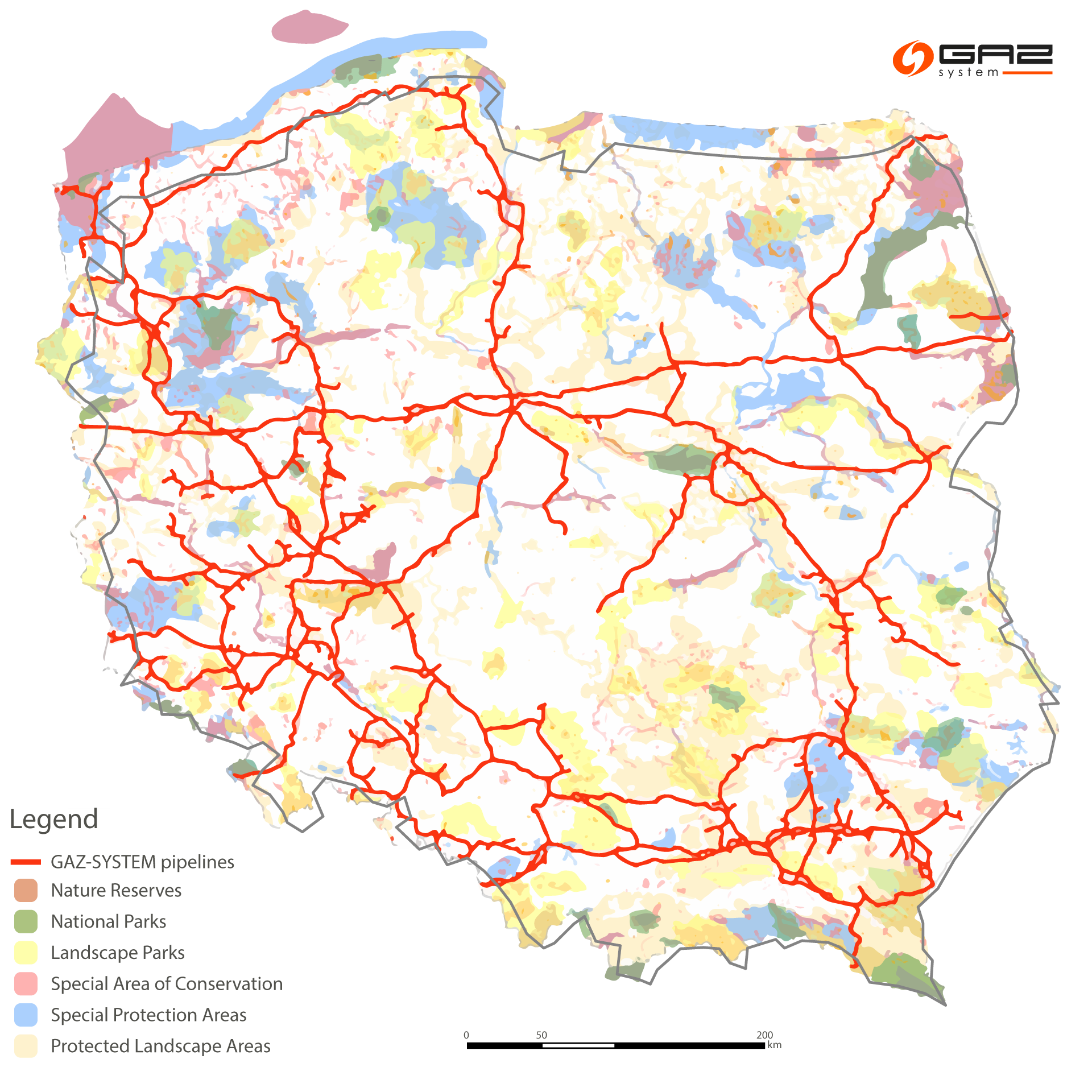
GAZ-SYSTEM recognises the following as protected areas:
- national parks,
- nature reserves
- landscape parks
- protected landscape areas
- Natura 2000 sites,
- natural monuments,
- documentation sites,
- ecological sites,
- nature and landscape complexes.
| Number of species likely to be affected by the organisation’s activities (without the application of conservation measures), by level of risk of extinction (based on the Red List of Threatened Species and the classification of the International Union for Conservation of Nature) | |
|---|---|
| At risk of extinction | Polish Red Data Book of Plants – 1 |
| Polish Red Data Book of Animals – 4 | |
| International Union for Conservation of Nature – 1 | |
| Nearing the risk of extinction | Polish Red Data Book of Animals – 6 |
| International Union for Conservation of Nature – 7 | |
| Lower risk, least concern | Polish Red Data Book of Animals – 14 |
| International Union for Conservation of Nature – 187 | |
The above data represents the total number of protected plant and animal species found in the locations included in the summary below.
Impact of GAZ-SYSTEM investment projects on protected areas
| Location | Location in relation to the protected area | Area of operation in km2 | Biodiversity category |
| Kujawsko-Pomorskie Province (municipalities: Brześć Kujawski, Włocławek, Kowal, Choceń, Baruchowo)
Mazowieckie Province (municipality: Gostynin) |
The Left Skrwa River Valley Protected Landscape Area | 4.5 | Terrestrial and freshwater ecosystem |
| Location | Location in relation to the protected area | Area of operation in km2 | Biodiversity category |
| Mazowieckie Province (municipalities: Gostynin, Szczawin Kościelny, Pacyna
Łódzkie Province(municipalities: Oporów, Żychlin, Bedlno, Zduny, Łowicz, Łyszkowice, Maków, Godzianów, Głuchów, Skierniewice, Rawa Mazowiecka)
|
The Left Skrwa River Valley Protected Landscape Area | 1.85 | Terrestrial and freshwater ecosystem |
| The Przysowa River Valley Protected Landscape Area | 3.05 | ||
| The Bzura River Valley Protected Landscape Area | 0.9 | ||
| Warsaw-Berlin Proglacial Stream Valley Protected Landscape Area | 1.35 | ||
| Natura 2000 site: Warsaw-Berlin Proglacial Stream Valley | 1 | ||
| Natura 2000 site: the Bzura-Ner River Proglacial Stream Valley | 1.05 | ||
| Bolimowsko-Radziejowicki Area of Protected Landscape with the Middle Rawka River Valley | 6.55 | ||
| The Rawka River Nature Reserve | 0.04 | ||
| Natura 2000 site: the Rawka River Valley | 0.3 |
| Location | Location in relation to the protected area | Area of operation in km2 | Biodiversity category |
| Łódzkie Province (municipalities: Rawa Mazowiecka, Regnów, Sadkowice)
Mazowieckie Province (municipalities: Mogielnica, Wyśmierzyce, Radzanów, Stara Błonnica, Jedlińsk, Głowaczów, Kozienice, Gniewoszów, Sieciechów) Lubelskie Province (municipalities: Puławy, Końskowola, Żyrzyn)
|
Natura 2000 site: the Lower Pilica River Valley | 8.1 | Terrestrial and freshwater ecosystem |
| Natura 2000 site: the Kozienice Forest | 2 | ||
| Natura 2000 site: the Pilica River Valley | 8.1 | ||
| Natura 2000 site: the Kozienice Refuge | 24.3 | ||
| Natura 2000 site: the Middle Vistula River Valley | 0.06 | ||
| The Kozienice Landscape Park | 2.4 | ||
| Bolimowsko-Radziejowicki Area of Protected Landscape with the Middle Rawka River Valley | 0.8 | ||
| The Pilica and Drzewiczka Rivers Protected Landscape Areas |
25 |
||
| The Wieprz Proglacial Stream Valley | 3 |
| Location | Location in relation to the protected area | Area of operation in km2 | Biodiversity category |
| Mazowieckie Province (municipalities: Nieporęt, Jabłonna, Łomianki, Stare Babice, Ożarów Mazowiecki; Warsaw districts: Białołęka, Bielany, Bemowo)
|
Kampinos National Park buffer area | 15.5 | Terrestrial and freshwater ecosystem |
| Natura 2000 site: Kampinos Valley of the Vistula River | 2.2 | ||
| Natura 2000 site: the Middle Vistula River Valley | 2.9 | ||
| Ławice Kiełpińskie Nature Reserve | 0.8 | ||
| Łosiowe Błota Nature Reserve buffer area | 0.1 | ||
| Warsaw Protected Landscape Area | 19.8 |
| Location | Location in relation to the protected area | Area of operation in km2 | Biodiversity category |
| Małopolskie Province (municipalities: Oświęcim, Chełmek, Libiąż, Chrzanów, Bukowno)
Śląskie Province (municipalities: Jaworzno, Sławków) |
Not applicable | Not applicable | Terrestrial and freshwater ecosystem |
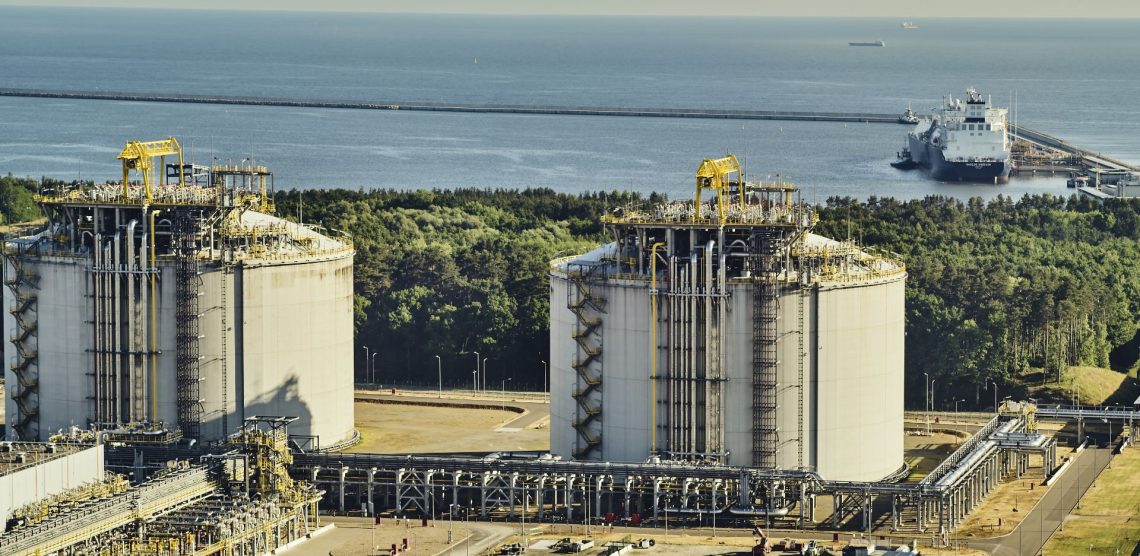


-
3-3
-
304-1
-
304-2
-
304-3
-
304-4 11.4.3
-
E-S5
LNG Terminal in Świnoujście – environmental impact
The LNG Terminal in Świnoujście named after President Lech Kaczyński is located within the Wolin and Uznam Natura 2000 Special Area of Conservation (protection type – Habitats Directive). The size of its operations area prior to expansion is approx. 48 ha. The Terminal is used for both process and office facilities.
The Terminal expansion is implemented under continuous environmental supervision. The Company activities have resulted in several significant changes in the local biodiversity:
- local reduction in the movement vertebrates due to permanent fencing,
- fragmentation and alteration of the range of natural habitats,
- expansion of non-native plant and animal species,
- displacement of forest animal species in favour of species preferring synanthropic habitats (transformed by humans).
The following habitats protected under the Natura 2000 network (according to the methodological guide of the Chief Inspectorate for Environmental Protection „Interpretation Manual of European Union Habitats”) are affected by the investment project implementation.
| Area type | Conservation status |
|---|---|
| sea shore wash margin (1210) | U2 |
| initial stages of coastal white dunes (2110) | U1 |
| coastal white dunes (2120) | U2 |
| coastal grey dunes (2130)* | U2 |
| mixed forest and coniferous forest on coastal dunes (2180) | U2 |
| FV – favourable, U1 – unfavourable-inadequate, U2 – unfavourable-bad, *- priority habitat | |
| Critically endangered | Sand couch-grass |
| Endangered | Dog lichen |
| Vulnerable | Migratory birds: common pochard, curlew sandpiper, northern lapwing, common redshank
Plants: dark-red helleborine |
| Near threatened | Migratory birds: Eurasian curlew, red knot, red-breasted merganser, horned grebe |
| Least concern | Insects: red wood ant
Amphibians: common toad, pool frog, common frog, common water frog, moor frog, common spadefoot toad, smooth newt, great crested newt, European tree frog Breeding and migratory birds: long-tailed tit, mallard, tree pipit, common linnet, goldfinch, greenfinch, common rosefinch, treecreeper, ringed plover, common wood pigeon, common raven, carrion crow, western house martin, great spotted woodpecker, yellowhammer, European robin, chaffinch, crested lark, Eurasian jay, barn swallow, red-backed shrike, woodlark, nightingale, white wagtail, spotted flycatcher, coal tit, Eurasian blue tit, crested tit, great tit, willow tit, marsh tit, sparrow, black redstart, common redstart, common chiffchaff, leaf warbler, willow warbler, common firecrest, goldcrest, nuthatch, Eurasian blackcap, garden warbler, common whitethroat, lesser whitethroat, Eurasian wren, common blackbird, song thrush Migratory birds: cormorant, herring gull, mallard, red-breasted merganser, black-headed gull, coot, crane, common gull, greylag goose, taiga bean goose, long-tailed duck, common merganser, velvet scoter, common scooter, goldeneye, grey heron, smew, mute swan, great black-backed gull, common buzzard, white-tailed eagle, whooper swan, great crested grebe, little gull, dunlin, scaup, willow tit, black-backed gull, gadwall, megpie, red-throated loon, Eurasian woodcock, sparrowhawk, tree pipit, lesser spotted woodpecker, Eurasian goshawk, greater white-fronted goose, mistle thrush, rough-legged buzzard, sanderling, peregrine falcon, Eurasian collared dove, European rock pipit, ruddy turnstone, common tern, green sandpiper, black tern, western marsh harrier, black woodpecker, great grey shrike, little tern, sandwich tern, owl, Montagu’s harrier, middle spotted woodpecker, common moorhen, red kite, grey plover, Caspian tern, tundra swan, horned grebe Mammals: Daubenton’s bat, brown long-eared bat, common pipistrelle |
As a result of the Terminal expansion works, some bird species have moved to neighbouring habitats and the project area was populated by such species as: black redstart, white wagtail, barn swallow, common house martin, hooded crow. Any maritime transport activity may lead to spreading invasive plant and animal species incompatible with the habitat. At present, the Lactuca tatarica (a species brought from Asia or North America) and the Rangia cuneata clam (native to the Gulf of Mexico) are present on the site. However, these are not species introduced as a result of the Terminal’s operations. The irreversible effect of the construction of the jetty with the transmission infrastructure on the natural environment is the alteration of the shoreline and direct destruction of plants in the areas occupied by the investment project.
As part of its remediation efforts, the Company is installing and monitoring nesting boxes for bats, removing invasive plant species and creating special areas for endangered and protected plants. There are plans to purchase nests for swallows and protection baskets for plovers. In order to protect and revitalise habitat areas, GAZ-SYSTEM is cooperating with the Regional Directorate for Environmental Protection and the Wolin National Park. All remedial measures resulting from the decision on environmental conditions and from the Nature Conservation Act are monitored and reported on an ongoing basis. After completion of the Terminal expansion works, there will be a slow stabilisation of the area (within about 5 years after the works’ completion). New biotopes will begin to emerge, becoming more stable over time and populated by new fauna species associated with anthropogenic habitats. It will be important to implement works supporting natural habitat regeneration (in accordance with the Conservation Action Plan) and to remove plant species incompatible with the habitat.
-
3-3
-
304-1
-
304-2 11.4.3
-
304-3
-
E-S5


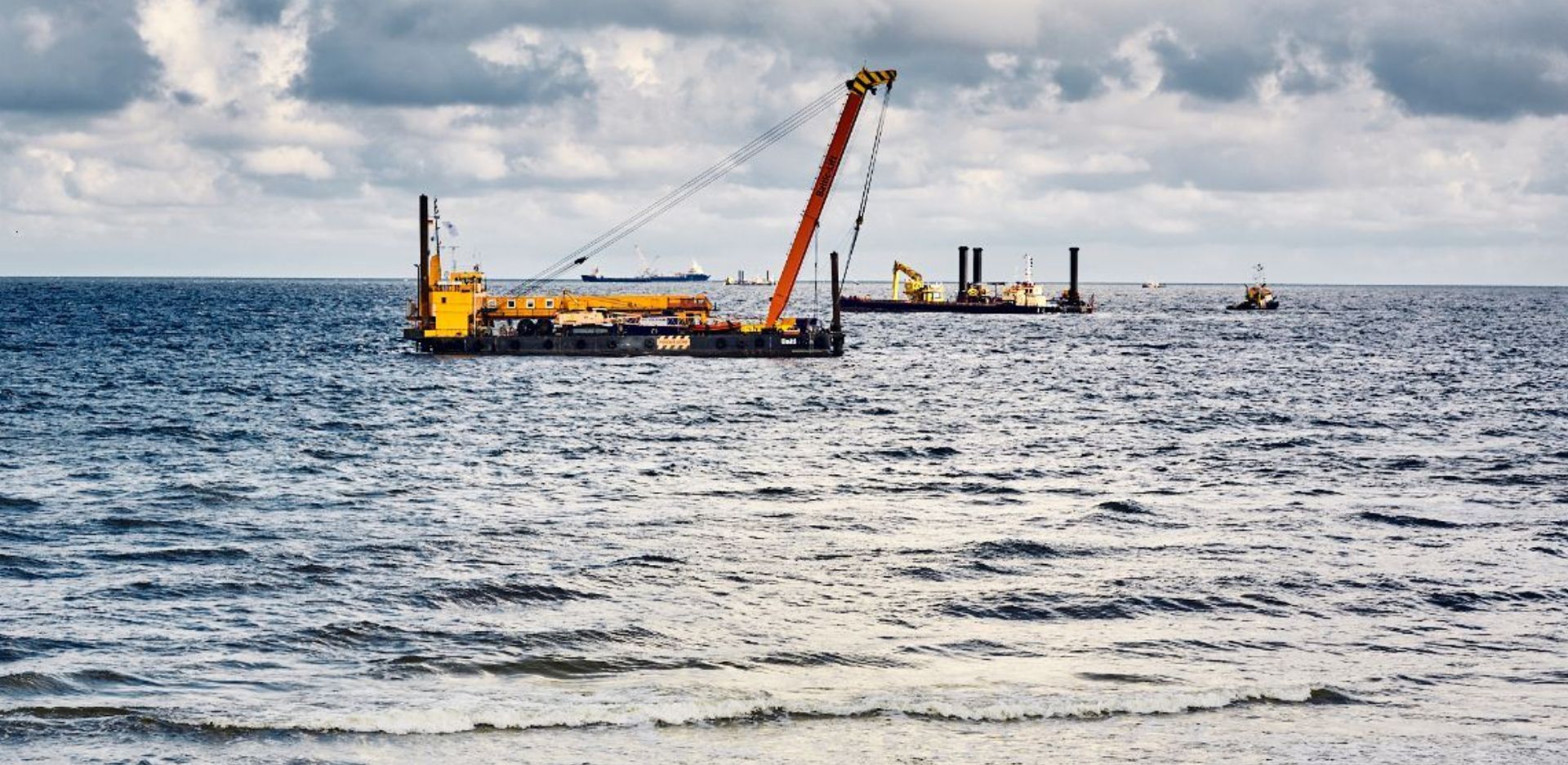
Baltic Pipe – environmental impact
In accordance with the issued Decisions on environmental conditions, GAZ-SYSTEM is obliged to reverse the environmental changes resulting from the construction and operation of the Baltic Pipe gas pipeline. Furthermore, the Company is obliged to monitor the environmental impact of its activities throughout the entire operation period. A number of activities were implemented in 2023 to comply with these requirements. Among others, seabed topography surveys, ROV (Remotely Operated Vehicle) inspections and sediment analysis in the Danish zone were carried out. The seagrass meadow surveys performed in Denmark showed an improvement in the condition and presence throughout the investigated area compared to 2022 (with the exception of the Baltic Pipe direct pipelay area). It is anticipated that five years after completion of the construction works, the pipeline, particularly in the Swedish waters, will have partially settled into the seabed and will not have a significant impact on the seabed topography or habitats.
The first visual inspection of the seabed near Niechorze was also carried out in 2023. The inspection showed that the morphological conditions of the seabed have not changed significantly. However, in the onshore area, the survey confirmed the presence and spreading of the wild black cherry, an invasive species. The Company has taken steps to eradicate this species. Rosa rugosa, another invasive species identified in the survey area, does not currently pose a significant threat. Plants identified as non-native and invasive, such as Erigeron canadensis and European black nightshade, are annual or biennial plants and their regular removal will prevent their spread to natural habitats.
-
3-3
-
304-1
-
304-2 11.4.3
-
304-3
-
E-S5
FSRU Program in the Gulf of Gdańsk – environmental
The area of the planned investment project, both offshore and onshore, is characterised mainly by medium and fine-grained sands. There are no documented mineral deposits or mineral extraction sites in the area. The project will be partially located in the amber prospective area XI – Gulf of Gdańsk with a total area of 47.3 km².
The offshore works, including dredging, related to the construction of the jetty involve alterations to the seabed surface. The environmental impact assessment (EIA Report) has shown that with mitigation measures in place (offshore noise and suspended solids displacement), the impact will be minor. In the onshore part, the main impacts of the pipeline construction phase will consist of tree felling, soil spreading by wheels within the limits of the planned construction sites as well as noise and dust emissions due to the movement of vehicles and construction machinery. The impact on the vegetation during the construction phase has been assessed as moderate. For gas pipelines crossing protected areas, the use of trenchless construction methods such as pipe jacking or tunnelling will be of key importance. Full information on the environmental impact of the project can be found in the “Environmental Impact Report for the Project: Implementation of the FSRU Terminal, Including Offshore Gas Pipeline Within the Basin of the Port of Gdańsk” can be found” (here).


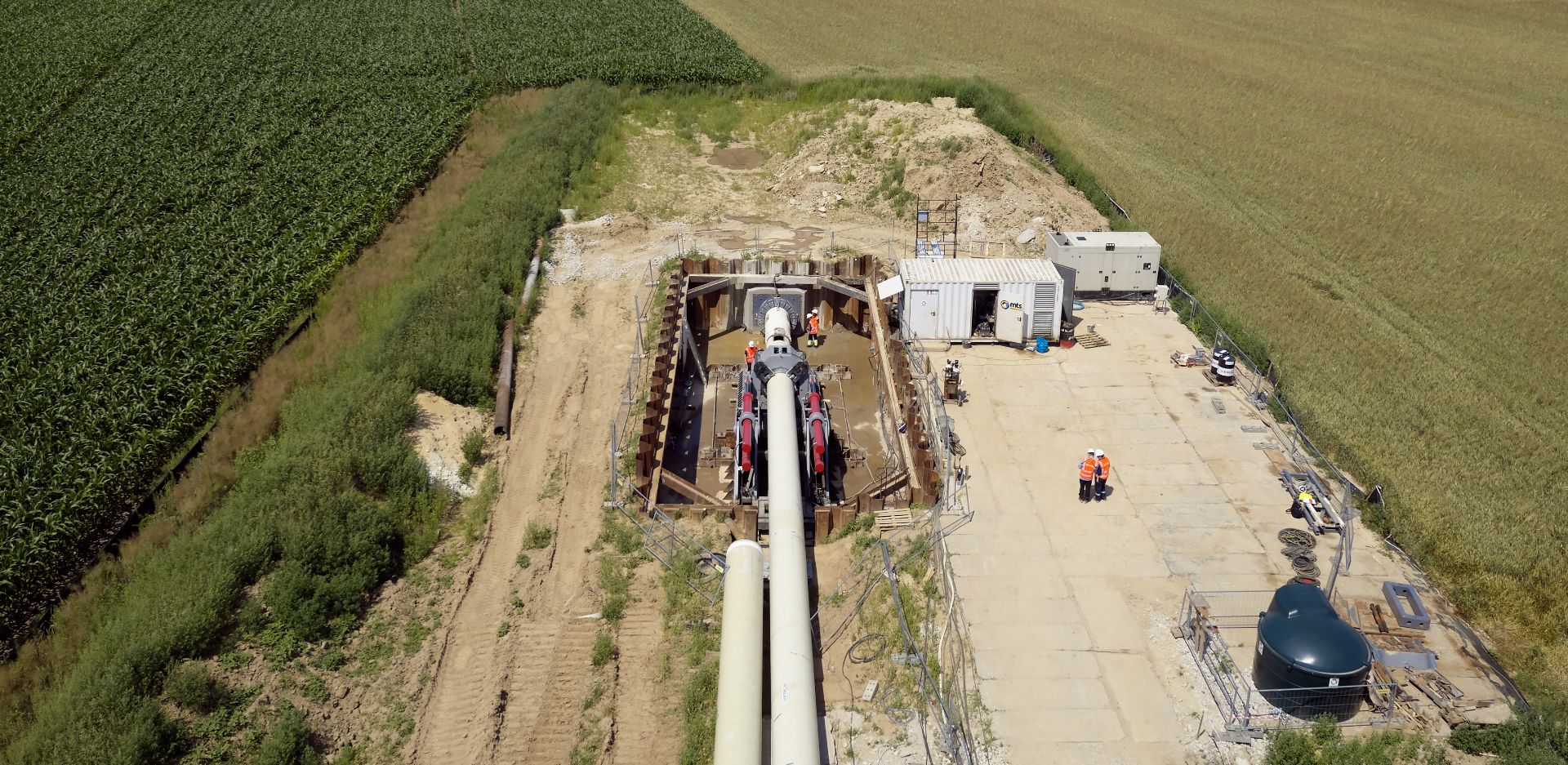
-
3-3
Trenchless technologies
GAZ-SYSTEM strives to apply environmentally friendly technologies. Trenchless methods allow non-intrusive gas pipeline routing under rivers, railways and roads – without the need to stop traffic during the works. Such modern technologies are economical and safe for local infrastructure present in the vicinity. Between 2016 and 2023, GAZ-SYSTEM executed several hundred trenchless crossings with a total length of more than 102 kilometres, to the benefit of both nature and local residents.
In 2023, as part of the redevelopment of the Goleniów – Police gas pipeline, the Company performed so far the longest in Poland (2 km and over 40 m deep) Intersect HDD (Horizontal Directional Drilling) crossing under the Olszanka Nature Reserve in Poland. The Intersect method involves simultaneous drilling with guided heads from two locations – at the entry and exit of the borehole. This makes it possible to complete a much longer borehole than in the case of standard one-directional drilling and creates a narrow tunnel into which the pipeline is then positioned. Thanks to the application of the trenchless technology, the unique peatlands of the Olszanka Nature Reserve and the white-tailed eagle habitat remained intact.


